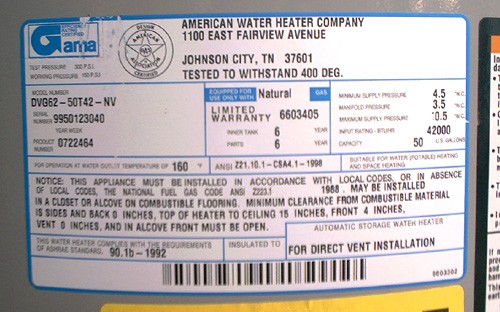- Serial Number Lookup For Equipment
- Free Serial Number Lookup
- Serial Number Lookup Specs
- Propane Tank Serial Number Lookup
04-21-2010, 10:22 AM | |
| |
We are going thru hi-jinks with Amerigas. We recently converted no natural gas, and have been approached by people interested in purchasing our tank. Our lp company, like yours changed hands several times before being bought by Amerigas. It was my father's understanding that he had initially leased (or rented) the tank in 1974, then in 1977 purchased it. They came out and replaced the tank, and scheduled a number of payments (which he paid). The only paperwork they can provide me with is the front of the original contract for the lease, with notations about new terms, (not what the terms pertain to) and a new serial number added. Where on your contract was the option to purchase? It is my belief the we own the tank. They, of course claim it for themselves, and also wat to charge us to empty it and remove it. I, understandably, would rather sell it to someone else. What do you think? We are in northern Wisconsin. Thanks Nancy |
Below are serial number lookup sections for every major water heater manufacturer. Column one lists all the various brands that manufacturer makes, column two shows sample serial numbers, and column three of each table acts as a serial number decoder.
1. Cost--Buying a new propane tank can cost you 50% to 100% more than a used tank. As the price of steel increases, new propane tank prices increase too. Prices vary depending upon supply and demand. Recently pricing on new tanks has dropped because there seemed to be excess inventory of new tanks as the domestic oil activity slowed down. This would then affect the price of used tanks.
Serial Number Lookup For Equipment
2. Availability Time--A new tank to your specifications can require several weeks to months for it to be built. If it is a distant manufacturer, then there are the additional transport costs. If you find a closer pressure vessel supplier, you need to consider their build schedule.

Free Serial Number Lookup
3. Sizing--It depends on how the tank will be used, bobtail refill station, rail bulk storage facility, single grain dryer, etc. Transport loads are about 9600 gallons, and you would need at least a 12,000 gallon tank to accept a transport load. Considering expansion room and not wanting to run it empty, an 18,000 gallon and up tank is preferred.
Serial Number Lookup Specs
4. Age--Propane tank systems have been in use for over seventy years and some folks consider older tanks much safer than newer tanks. As the price of steel has increased, the thickness of the steel used has been reduced resulting in a lower safety factor for new tanks. If tanks were used in anhydrous ammonia then they need to be washed out to remove any traces of ammonia and the fittings such as valves need to be replaced with the correct type and material. Also, as a general rule, old rail car tanks cannot be used. As long as the tank has been maintained/painted and fittings kept up to date, age should make no difference.
5. Board Certification--Many tanks have National Board numbers or U1A reports, which mean that the specifications of that specific tank is on file and is fairly accessible for a certain fee. Tanks with the certifications can be used in more states and would have a greater resale value. Wisconsin, for instance requires this certification while most other states including Minnesota do not require it. The U1A is in effect the birth certificate of the tank.
6. Governing Codes--Propane tanks/systems oversight is through the Authority Having Jurisdiction such the local fire marshal. Each locality would determine the extent of what is required in their jurisdiction. Wisconsin systems require additional inspections and the State Fire Marshal needs to get involved for large systems. In North Dakota, the boiler inspector gets involved. The NFPA-58 (National Fire Prevention Association) is the governing code in most cases. The key parts of the code to consider are the tank size and the set-backs from primary buildings, roads, equipment, and property lines. Check with your state or local officials before buying a tank. There may be different requirements such as maximum allowable working pressure of 250 psi rating, etc.
7. Manufacturer’s plate--Be careful to take care of the plate which was attached to the tank at the time of manufacture. If the plate is missing or comes off, you do not have a propane tank. It is hard to convince an inspector that the loose plate actually came from the tank you said it came from. Information on the tank gives specifications such as steel thickness, year, Board number if any, serial number, capacity in water gallons, manufacturer, length and diameter. Make sure it is readable and has the “U” ASME stamp. I once asked a lady if she could send a better picture of the data plate of the tank I was interested in. She actually removed the plate to make a copy on her copier. Don’t do that!
Propane Tank Serial Number Lookup
When you are looking for good used tanks, go to http://www.farmpropane.com/inventory.html